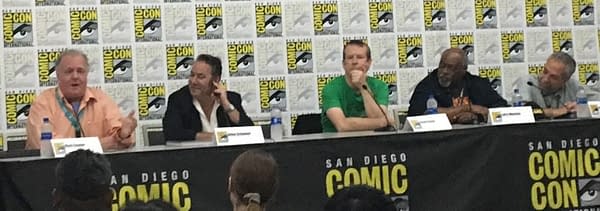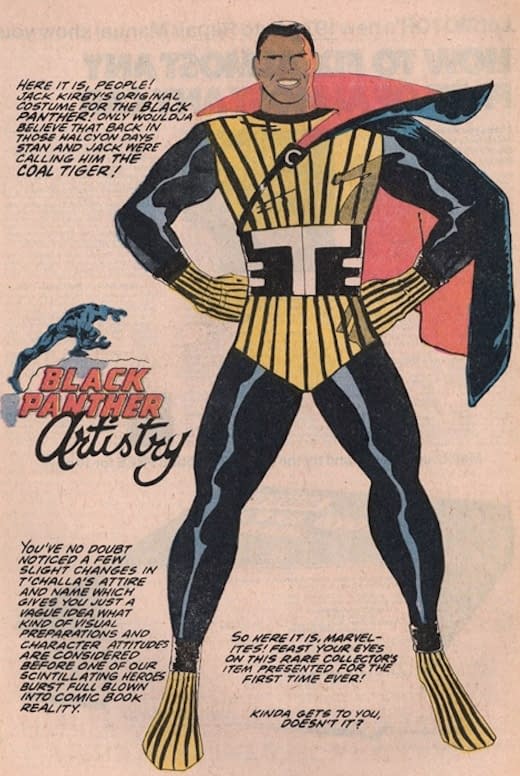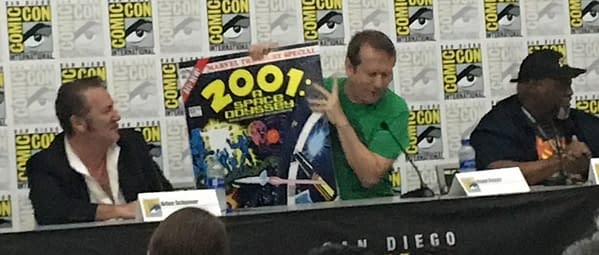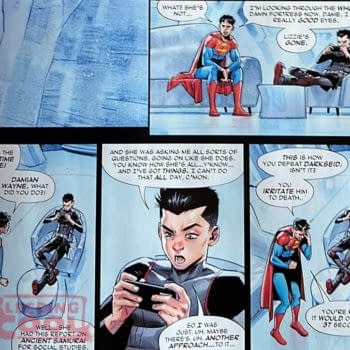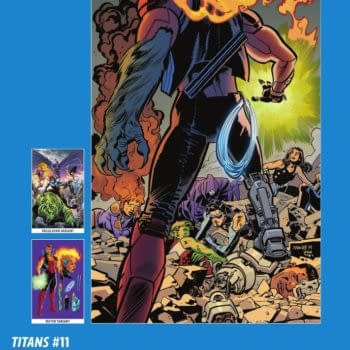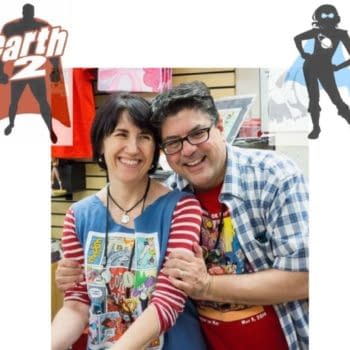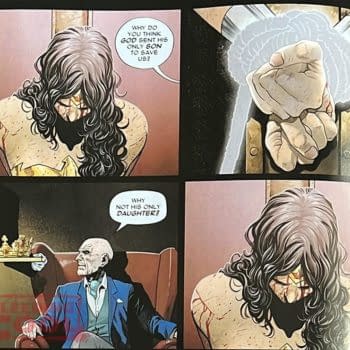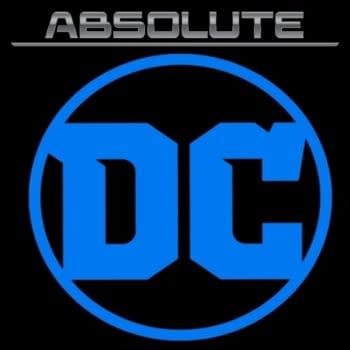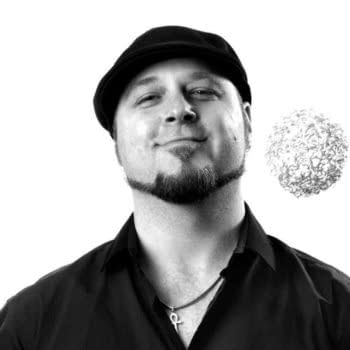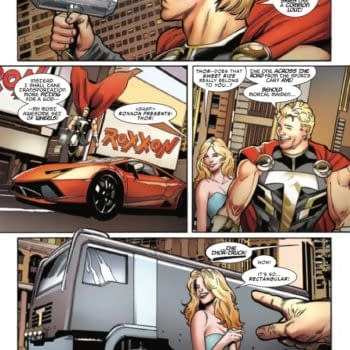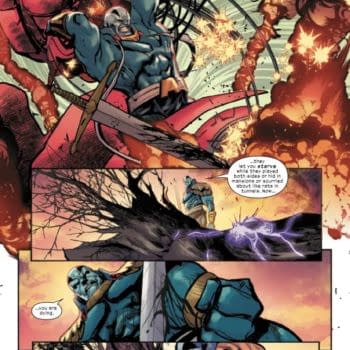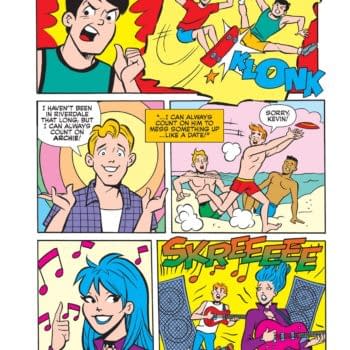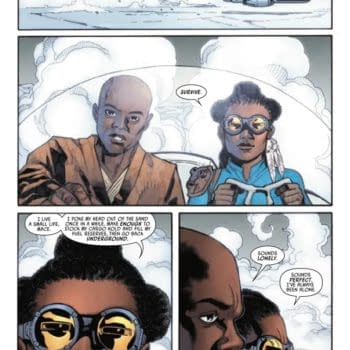Posted in: Comics | Tagged:
Separating the Truth from Fiction at the Annual Kirby Tribute San Diego Comic-Con Panel
Mike Sangregorio wrote from San Diego Comic-Con,
Sunday during Comic-Con means a few things. It means you are almost done so just hang on for a few hours more. On the upside, it means that the first panel of the day is the annual Kirby Tribute Panel hosted, as always, by Mark Evanier.
Evanier is a noted creator in his own right but is a famed comic historian and was Kirby's assistant for part of his career. He was joined on the panel by Arlen Schumer, lecturer, Rand Hoppe, of the Kirby Museum, Larry Houston, illustrator, and Paul Levine, legal counsel for the Roz Kirby trust (aka 'The Kirby Estate'). He began the morning by chiding the audience for not having as full a room as he would expect. "In baseball, if they don't sell enough tickets, they don't televise the game." By the halfway mark the room was filled.
Evanier mentioned that he has attended all 49 instances of the convention, through its various names and locations. "Only 5 of us can say that." Kirby gave a speech at the first convention. He also drew something in front of the crowd. Evanier recounts that Kirby did not care for drawing in that type of setting and the result was "the only time I thought I could do better."
Evanier is currently working on new book which he "promises is almost to the printer." He says that one of the delays is that he "has to keep crossing things out as 'rumor'." Evanier discussed the trouble with having to fact check stories about Jack Kirby as so many have been retold over the years that they have been accepted as fact when they are sometimes not.
One example cited is Robert Bernstein (classic Aquaman writer) supposedly waiting on a train platform until he saw the car go by that contained Kirby. Bernstein would then ask Kirby for story ideas as the former was on his way to pitch his editor, Mort Weisinger, at DC. This was cited as something that was rumored to be true until, both, legendary creators Gil Kane and Arnold Drake confirmed the events.
Other stories include one that Kirby performed ghost-artistry on the comic Hopalong Cassidy during the 1950s. Evanier added that that strip's creator, Dan Spiegel, was one of the few who was actually faster than Kirby and that this was not true.
A story that did involve Spiegel, who was not overly familiar with superhero comics, was that when he was hired to draw a Superman comic for Radio Shack and asked for reference for Lex Luthor he was told to draw the character to resemble actor Telly Savalas. He did this so well that Superman appears to be fighting the famous actor and not his arch-nemesis.
Evanier said that in all things, not just Kirby comics, we should "ask yourself, how do we know this?" Evanier followed this thought by saying that "Jack Kirby did not make Jimmy Olsen into Thor" and he "did not create Metallo, which I have seen cited because of the similarity to Iron Man's origin."
Schumer stated "I kind of like being around people who like Jack Kirby" and discussed his belief, expanded upon at a different panel later in the day, that much of what is understood about the creation of Black Panther is incorrect or based on incomplete information.
He shared well-known art by Kirby featuring the original character design labeled as the Coal Tiger. This version does not have a mask. Even the original cover for the issue where the character ultimately appeared had a half-mask that was erased and replaced with a full one. Schumer believes that Kirby intended for Tiger/Panther to be a hero more in the vein of Captain Marvel and not Batman, as is widely believed. The character may have been adapted to fit that mold because it was 1966 and the Batman television series was on everyone's mind at the time.
The original character's design, with a half-cape and a color scheme widely different than the final product, hint at a different direction from what Marvel ultimately produced. Schumer concluded that "as a historian, I will always side on the side of Jack Kirby." Evanier believes that Kirby, not Stan Lee, named the character because "Jack served with [General] Patton who had a tank regiment who were called the Black Panthers."
Hoppe updated the audience on the activities of the Kirby Museum. On Mother's Day the museum had a pop-up store in New York which spotlighted Kirby's comics based on the 2001: A Space Odyssey film as this was the 50th anniversary of the movie.
The exhibit featured, among other attractions, a recreation of one of the Monoliths from the film and a giant version of the first issue, several feet across, which Hoppe brought to show off. Evanier added that "that's exactly the size that Jack would have wanted. He always said that all comics should have been that size." Hoppe discussed how the issue was a labor of love, painstakingly constructed from the best versions of the original art available.
Jean Depelley, co-director of the French documentary Kirby at War, was on-hand to discuss the screening of the 52-minute film earlier in the weekend. He said that among the other facts he uncovered about Kirby's time at war was that he listed his trade as 'mechanic' when he enlisted.
Chris Thompson from Titan Comics discussed their plans to collect the Kirby Collector magazine as well as Kirby's work on the comic adaption of the show the Prisoner. This oversized, deluxe edition will feature all of Kirby's work "as well as a dozen or so pages by Gil Kane."
John Morrow, publisher of the Kirby Collector, said that the next issue will be a double-sized 'Stuff Said' issue. "Only quotes, specifically those dealing with the chronological history of the Marvel Universe. Their actual words, minimal interpretation or analysis." Morrow stated that this would include Stan Lee, Jack Kirby, Steve Ditko, and Wally Wood.
Morrow added that he is currently working with DC on a collected edition of all of Kirby's unpublished work for the company. This will include stories from True Life Divorce (also known as True Divorce Cases) and two stories featuring the Dingbats of Danger Street. He asked that if anyone has original art, or scans, of anything that was unpublished that they contact him because he wants to ensure that this collection has the highest quality available work.
Hoppe added that the Kirby Museum is building a library of all of Kirby's artwork for use in a variety of future projects.
Levine discussed the fact that it was a pleasure to be here and that until then "all of the projects discussed here are file folders in my office."
Evanier showed various photos. The first was from 1979 or 1980, featured Don Rice, Mike Royer, Kirby, and Sergio Aragonés, and was taken by Evanier at the Los Angeles Library.
Rice was an artist for Timely/Atlas and a friend of Kirby's. The picture was Aragonés' copy, given to him by Kirby's wife Roz at her husband's funeral.
Two versions of the same artwork featuring the character Beautiful Dreamer, from the Forever People, are shown. The first has her in a one-piece bathing suit. The second has her in a bikini. Evanier mentions that Kirby edited the latter into the former because he "was afraid he had actually drawn pornography" due to the positive reactions to the image of a group of student-fans who were shown the artwork when they were visiting the Kirby home.
Kirby is shown with Adam West and again with classic Outlaw Kid artist Doug Wildey. Evanier once worked with Wildey on a Daredevil cartoon for which Wildey charged $5,000. When Evanier asked why he had charged that much when he was only offered (and therefore most likely to receive) $3,000 the artist responded that the additional $2,000 was for all of the times Marvel had reprinted his work while only paying him for the first time he drew it. This was apparently after he had gone back to Marvel and asked to be paid "even if it was just the difference between the original page rate and that of the time when the work was reprinted."
Another picture is of Kirby with future Garbage Pail Kids co-creator John Pound. Evanier revealed that he was one of the fans who originally helped found this very convention. Earlier in his career he was tasked with inking Kirby, in place of Mike Royer, but that he ultimately proved not to be as consistent or speedy as was needed. Evanier described him as "a Kirby disciple."
Houston was producer of X-Men the Animated Series, among his other accomplishments. He remembers being welcomed into the Kirby home. "I walked into his home and as far I was concerned I was walking into Asgard." He remembers that about 90% of the people he worked with on X-Men were vocal Kirby fans. They used to bring in their own comics to photocopy and have as reference for the compositions of a shot to be accurate.
Houston added that Kirby was drawn into the Mojoworld episode. He is one of the 'aliens' in the clapping audience shot that is used several times.
Evanier claims that Kirby felt unloved during his second Marvel tour (during which time he worked on comics such as Black Panther and the Eternals) but that when he left and went to animation he had the exact opposite reaction. It was there, not amongst his comic peers, that he received adoration from fans and appreciation from those who were inspired by his work.
The panel came to close as most panels about Kirby do, discussing who inked him the best. Barry Windsor Smith inked a few pages of Kirby's Captain America: Bicentennial Battles which some fans believe to be too different from the Kirby style. Evanier has a page of Hawkman by Joe Kubert and Murphy Anderson. When he was on a panel with them both each agreed that said page would have been better if either man had done both pencils and inks.


